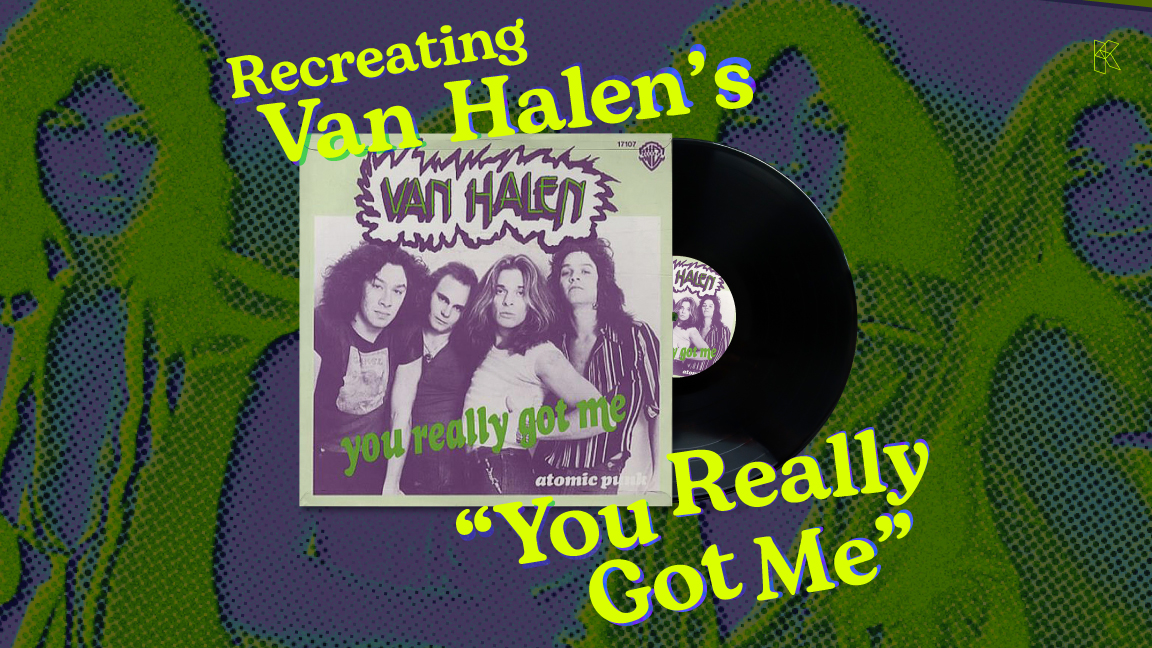
Music knows no limits, to create music means to push these boundaries and move into an unknown world, a world of dreams, hopes and love.
It’s like the excitement when hearing their song on the radio for the first time, even after 13 albums, the feeling was as strong as the first time.
Perhaps it is exactly the excitement that drove that creator to discover new unexplored territories in his music and create unique hits in their energy.
The song that we will recreate today is called “You Really Got Me”.
The band “Van Halen” released this single in early 1978. We should mention that it was a cover of a single by “The Kinks” which was released about more than ten years earlier.
A little bit of a story for the song.
Van Halen’s record company at that time decided to release this cover version instead of an original song, and it was worth it because it did gain popularity and success. In those early days, many bands including Van Halen used to play in clubs as a human jukebox. With a repertoire of over 200 songs and mostly from their favorite, The Kinks. The track “You really got me” kinda happened to be a choice to be released as a single. Of course the new sound of the song, refracted through the prism of the legendary Eddie, as you guessed, sounded incredibly different from the original, thanks to his revolutionary guitar tapping technique and catchy melodies. First in the United States and not after a long period all over the world, “You Really Got Me” blew away the radio stations and took the band into the top 40 pop charts.
Driven by a challenge, as always, once again Kuassa dives into the deep waters to uncover and recreate the sound of this beloved song and thus let us all touch the legendary Eddie, playing with his sound.
Thank God the time that the song was recorded in the studio wasn’t so long ago and we can take pretty good and correct information about Eddie Van Halen’s gear. Surprisingly the guitar that he used for the record wasn’t his Frankenstrat but the Ibanez Destroyer “Shark” with humbucker pickup and tremolo system. In order for the note to sound like it was being turned on and off, his neck pickup was disengaged and it allowed him to toggle back and forth, while bending the G string at the 7th fret. This staccato sound at the end of the guitar solo was very distinctive performed with this innovative technique.
We’ll take a look into Eddie’s choice of amplifier. In his early career he played with Marshall Plexi with 4×12 cab and therefore the song was recorded with it. In some cases he even stacked 3 heads daisy-chained together. In front of the amp he used the MXR 10 band EQ for boosting the amp and shaping the tone, more in the midd range. Then the MXR Phase 90
particularly for the solo parts and lots of fine details in his amazing rhythm riffing parts. Also by listening to the song in the studio he used some kind of plate Reverb tank and it is panned boudly, more on the right side. Perhaps the more compression you can notice and the less headroom are results of using Eddie’s Variac. About the Gain, it was much but some of it was from the EQ that Eddie used a lot those days. Yes, the EQ was a clean boost and a tone shaping tool.
Creating the tone with our freshly released software amplifier Amplifikation VVV is not a complicated task. The VVV Amp represents Eddie’s latest signature amps made by Peavey and all the channels work like a charm. It’s easy to get them producing the same British cranked tone, just like his old Marshalls. The VVV Amp A is based on the earliest models and it has quite a ”vintage” tone. Maybe it’s neglected by the modern metal players, but the amp is giving that: raw and maybe, maybe the brown sound. Of course, if it is tweaked carefully!
You can lower the bias almost at zero, then push the sag and after that crank the master. You have to experiment with your guitar, pickups and audio interface. But let’s face it, it’s an amp that delivers tone without too much hassle. Just a few turns on the knobs and you are in the ballpark.
https://www.kuassa.com/products/amplifikation-vvv/
The chain starts with the phaser.
Then there’s the Phaser, almost a signature to Eddie’s tone and solos. We’ve added it just to complete the pedal board and the preset – the rig.
You can engage it during your solo session, or just leave it off if needed.

Then there is an EQ pedal

It’s there for a reason, to boost the amp during the solo and most noticeably, it uses the opposite of the smiley face curve, the frown one.
Then you can see a Delay pedal in front of the amp. Why? You would ask. Well, some of his old EchoPlex Delay units were used for a little slap back delay, just to fatten up the tone and then more magic… To utilize the unit pre and give some more gain and boost.

After that there’s the amp. With moderate settings just to fine tune to overall guitar sound.

You can see the Bias is lowered to clean the amp head room and to get a more tight low end.
The Ribbon mic is added for more lows and the classic 57 is there on a second cabinet for the foundation of the sound.
And after the amp there is another EQ with the opposite curve, it’s a final sculpting part of the whole sound and after lots of research, we can see in Eddie’s live rigs, two EQ devices in his pedal board.

The final stage is a combination of a delay and reverb

The delay could be switched during the solo. The reverb stays engaged during the whole song.
There are two Live scenes saved, for the rhythm and the solo part.
And here is the full preset in our Amplifikation 360 software
https://www.kuassa.com/products/amplifikation-360/

No matter what words we are going to use to describe the legendary Eddie Van Halen, probably they will always be not enough, but from the moment he bursted onto the scene till he died we witnessed the evolution of rock music and sound like we’ve never heard before. We can only imagine what music he would create today. Such an amazing musician! We will miss you forever!
Here you can hear the tone. The guitar is an Ibanez RG320 with stock pickups.
Audio Sample:
https://drive.google.com/file/d/1Tedc4_D-KPzljdFWkNo2p7wSeB0l7UxR/view?usp=sharing
Here you can download the preset and copy it to your presets folder:
Link:
https://drive.google.com/file/d/111PAC5thE2vuCJRXeKtQSwN37kDPolcS/view?usp=sharing
The preset file for A360 looks like this: VH – You Really.ka360p copy the file after extracting it from the zip file at:
Presets folder:
Windows:
C:\Users\[User Name]\Documents\Kuassa\Presets\Amplifikation360
Mac:
/Users/[User Name]/Music/Kuassa/Presets/Amplifikation360
Stay tuned for more tones with history, explanation and preset for download!

